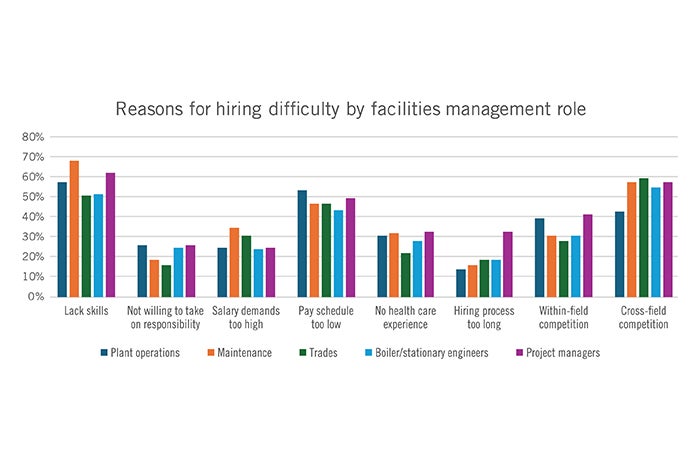Finding and hiring qualified professionals

Data from the 2023 ASHE Membership Survey
Given the professional concern over current and upcoming workforce shortages, the American Society for Health Care Engineering (ASHE) included a block of questions on this topic in its last membership survey. This article is the last in a series on workforce development and succession planning and quantifies respondents’ reasons for hiring difficulties across facilities management roles, explores potential patterns in hiring difficulties by specific roles and provides recommendations to assist facilities management leadership in workforce development.
ASHE membership survey respondents with workforce management duties described the reasons they thought were most responsible for hiring difficulties across a variety of facilities roles. Respondents were able to endorse multiple reasons because the hiring process can be impacted by many factors. The most-cited reasons for hiring difficulties across all facilities roles, in order of endorsement, included candidates lacking skills necessary for the role (57%), cross-field (non-health care) competition (52%) and organizational pay schedules set too low to be competitive (42%). Other reasons for hiring difficulties included candidates lacking health care experience (34%), within-field (health care) competition (32%), candidates demanding too high of a starting salary (29%), candidates unwilling to take on responsibilities of the role (22%) and hiring processes taking too long (22%).
These results point to two intersecting factors that drive workforce development issues. First, hiring managers cited skill deficits and a lack of health care experience as the most important barrier to workforce development and succession planning. These two factors drive hiring difficulties across all roles but are particularly important when attempting to staff maintenance and project management positions. Second, hiring managers also describe how cross-field and within-field competition create financial barriers to attracting and hiring qualified candidates. This intense competition highlights what many managers anecdotally explain as the key financial reason managers cannot staff their departments appropriately with the most qualified individuals — candidates often demand too high of a starting salary, or the hospital leadership has approved a pay schedule for that role that is far too low to be competitive.
Because director-level positions are projected to be one of the most in-demand, and many organizations prefer to promote from within, facilities management departments may want to explore collaborative educational opportunities with membership organizations and other vendors that offer project management training to upskill their current workforce in the management of people, projects and budgets, rather than looking for people new to the organization. Facilities management departments may also consider developing collaborative relationships with local junior and senior high schools or trade schools to create apprenticeships or shadow programs.
Finally, managers should build a case to inform senior leadership about the potential salary disparities for both within-field and cross-field roles. If directors do not already track and compare salaries for key roles within their departments, they should consider doing so for their regional areas. To address salary disparities when competing outside of the health care field, directors should consider gathering concrete evidence of salary disparities across the most competitive fields and documenting the potential negative impacts of understaffing to inform case studies that can be used to educate senior leadership.
Although anecdotally agreed upon within the profession, only one report has cited salary disparities between health care facilities management and other industries. It is an article by Steven Call in the journal Facilities, vol. 41, no. 7/8, 2023. Additional evidence is needed to quantify exact salary disparities using a larger sample and stratify salaries by role, tenure and geographical area, cross-validating with Department of Labor statistics. Creating a case using this information can assist facilities directors in future salary band negotiations.




